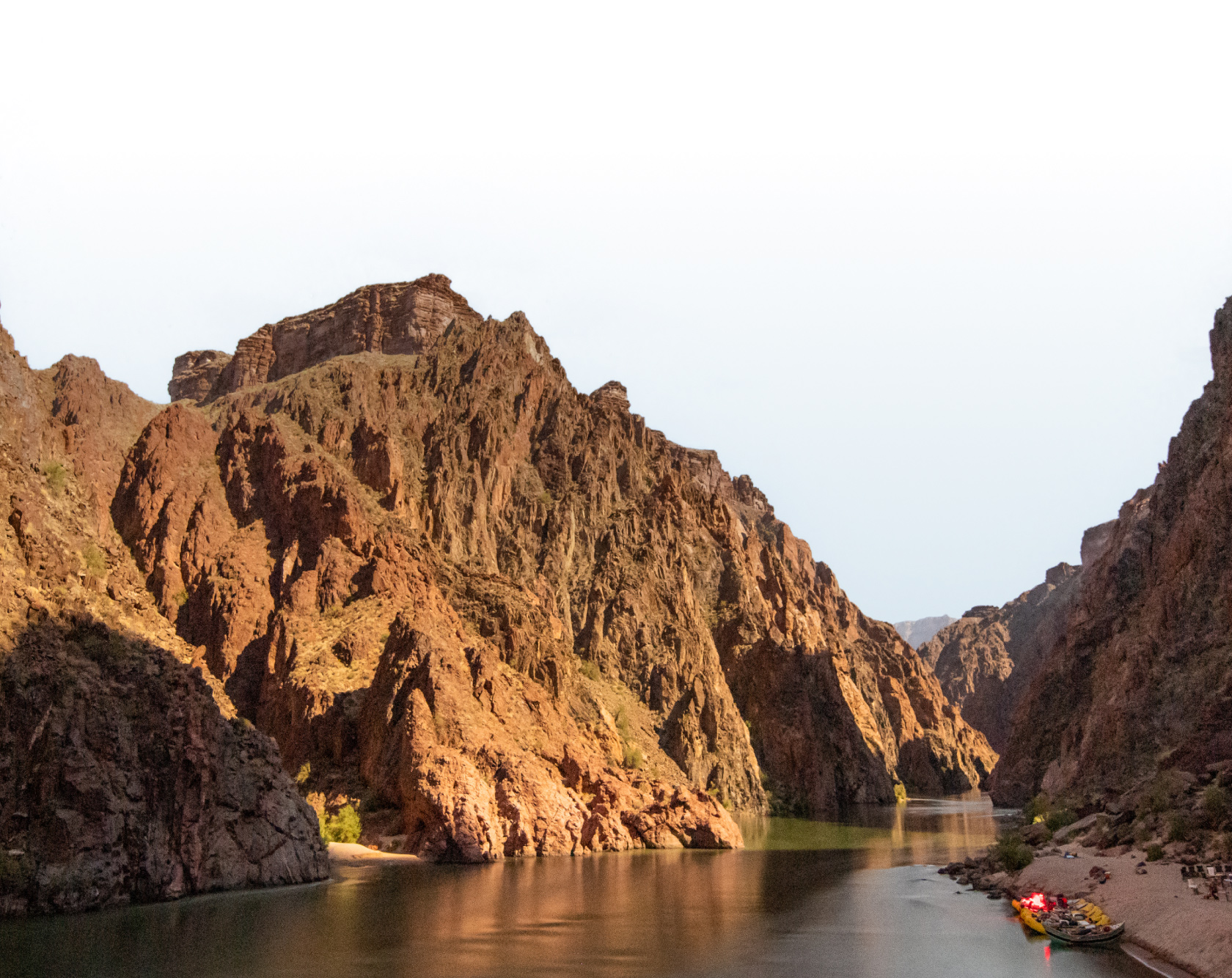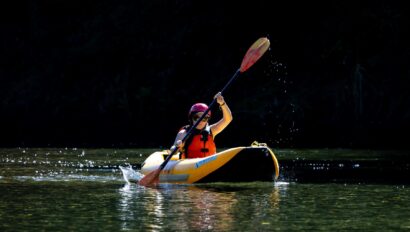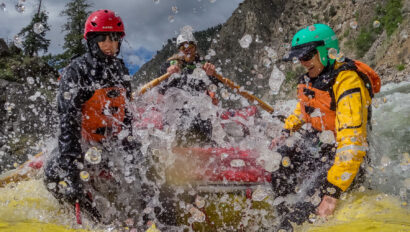A (True) Beginner’s Guide to Stand Up Paddleboarding

Stand up paddle boarding has exploded in popularity in the last decade. And for good reason. Stand up paddleboards (SUPs) are fun, versatile, and easier to pilot than they may appear. SUPs also provide an active way to explore your local waterways from a unique vantage point. If this sport has piqued your interest, this short guide offers a few stand up paddleboarding tips for beginners looking to give it a try.
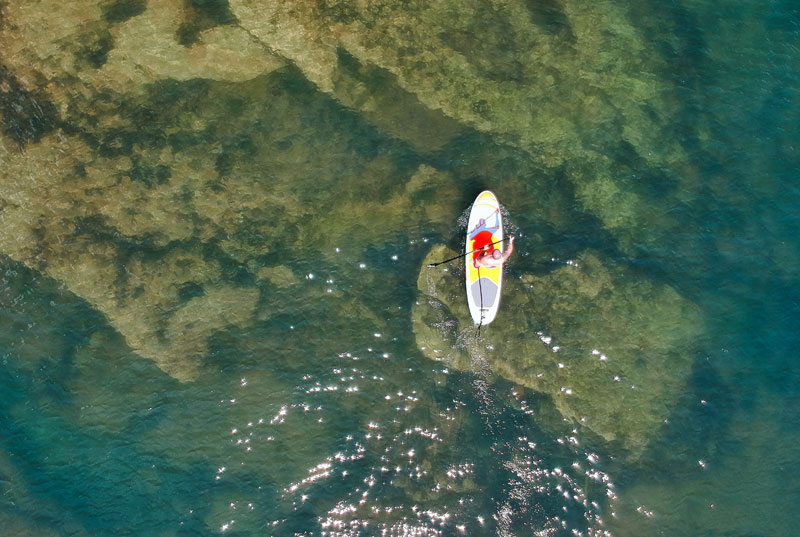
Pick the right location
Most beginners won’t want to start stand up paddle boarding on moving water. To make your first experience both fun and safe, it’s best to get out on a small lake or protected bay.
- Try to find a calm location that doesn’t have a ton of motorized boat traffic or a lot of wind. Winds can pick up during the day before settling down in the evening, so mornings and evenings are typically the best times for stand up paddleboarding.
- The warmer the water, the better. If you fall into frigid water and can’t get back on your board quickly, hypothermia can become a serious risk within minutes. Wetsuits are recommended when you’re paddling on cold bodies of water and during cooler months.
Get to know the basic SUP gear
While stand up paddle boarding isn’t necessarily a gear-intensive sport, beginners should familiarize themselves with the basic gear before they hit the water.
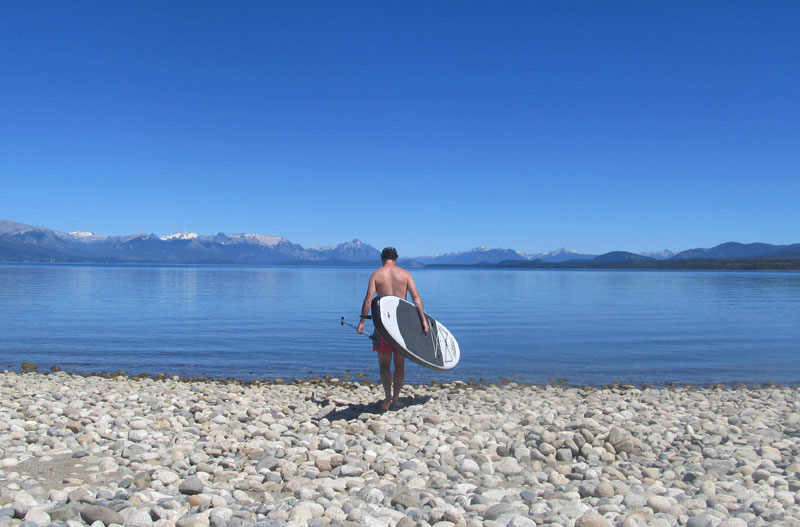
SUP Board
- Be sure to check out how deep the fin (or fins) go into the water. When you start paddling, you’ll want to pay attention to water depth, so the fin doesn’t run into the ground or a rock and send you off the board.
- Note where the carrying handle is; you’ll want your feet to be shoulder-width apart, with your toes just forward of the handle. Check for other handles or spots to grab the board if you fall off.
- Check out the d-rings and bungees that may be on the board. You can use these to connect a water bottle or dry bag with snacks and sunscreen to the board with a carabiner. If positioned on the front or back of the board, they can also be used for towing if you, or a paddling partner, run into any problems on the water.
SUP Paddles
- Paddles have three parts – the handle, the shaft, and the blade. First off, see if the paddle you’re using is adjustable and then adjust it for your height. Generally, you want the paddle handle to be six or so inches above your head.
- Check out the paddle’s blade angle. Most SUP paddles have an angled blade, and many beginning paddlers use the paddle backwards. It’s a little counter-intuitive, but as you hold the paddle in your hands, the blade should be angled forwards, not backwards. Some paddles don’t have an angled blade; instead they may have a slight curve or other design element. The inside of the curve should be facing the back of the board.
Leash
- Leashes may be stretchy or coiled and are meant to keep the board near you if you fall off. The leash will attach to a d-ring on the back of the board and you’ll wrap the other end around your ankle using the Velcro strap for a snug fit. If your board doesn’t have a leash, don’t worry. In fact, for safety reasons, leashes aren’t recommended on moving water like rivers.
PFD
- Look over your PFD and adjust the straps so that it’s snug, but comfortable. Be sure it’s cinched tight. Loose PFDs will float up off your body if you fall in, which can be uncomfortable and dangerous.
- Remember, bringing (and wearing!) a PFD is always a good idea, but consider it mandatory when stand up paddling on moving water.
Learn how to stand up paddleboard
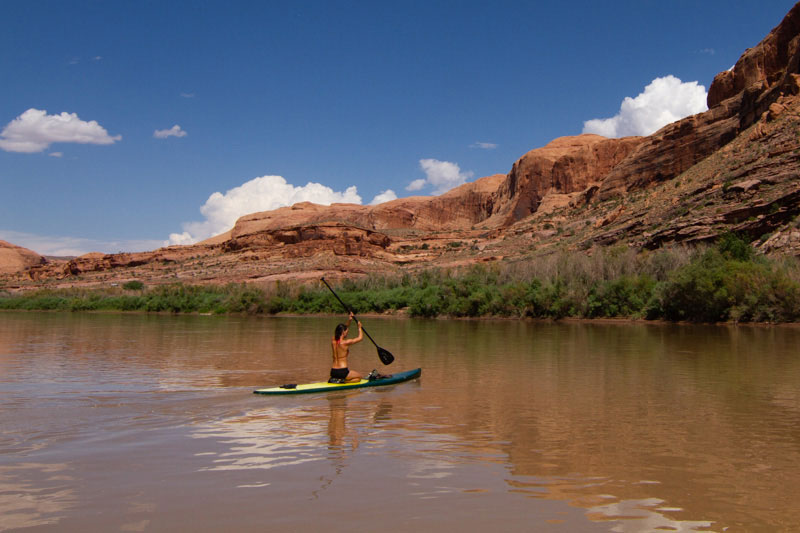
1) Knees First: Test you balance & confidence
- The lower your center of gravity, the easier it is to balance on a stand up paddleboard. Starting on your knees is a good way to get a feel for the basic paddle strokes (more on those below) and for the board as it moves through the water.
- Push the board out into the water far enough that the fin clears the ground. Place the paddle along the centerline of the board with the blade facing forward, towards the nose of the board. Place your hands on the board a few inches in from each edge and forward of the carrying handle/strap. Slowly put one knee on the board. You’ll want to put your knee a few inches in from the edge of the board and just forward of the carrying handle or strap. Use your hands to keep the board steady in the water. When you feel steady, put your other knee on the board so you’re facing forward.
- At this point, both knees should be a few inches in from the edge of the board, roughly shoulder-width apart, and an inch or two forward of the carrying handle. Float for a moment to get a feel for how the board interacts with the water. When you’re ready, pick up the paddle by pulling it up between your knees.
- Reach forward with the paddle (double check that you’re using it correctly) and put the blade into the water. Pull back through the water until the blade reaches your knees and then pick the blade up out of the water and reach forward again.
- You’ll notice that you move forward but also turn away from the side of the board that the paddle is on. After your second forward stroke, switch the paddle to the other side of the board and take two more strokes. The board will swing back in the other direction. By paddling a few strokes on either side of the board at a time, you’ll be able to steer the board in a straight-ish line.
- Practice turning the board 180 degrees in both directions. Notice how long or how quickly the board swings around and faces the other direction. Take a couple of backwards strokes by flipping the paddle around and paddling backwards along the edge of the board.
2) Time to stand up.
Once you feel confident on your knees, try moving to your feet.
- Place the paddle back along the centerline of the board, blade facing forwards. Move forward a bit so your feet are in line with the carrying strap.
- With your hands planted on the board, rise up off your knees in a downward dog style position, or in a crouching position. Slowly stand up and lift the paddle off the board as you do so. Your legs will likely be shaky as you get used to the board underneath your feet. Bend your knees and try to relax.
- Try a few forward strokes then switch sides and try a few more. Like a bike, the board will become more stable as it moves through the water.
- Try shifting your weight a bit to either side to get a feel for how tippy the board is or isn’t.
- Take deep breaths and keep your knees slightly bent and your legs engaged. Double check that your feet are in the right position – shoulder width or so, toes just ahead of the carrying handle.
3) Come back to shore.
After a bit of paddling, practice coming back into the shore. This is probably the most dangerous part of paddling for beginners – falling onto the shore from a standing position can cause real injury to your head, arms, or feet. Go slowly!
- It’s safest to drop back to your knees as you get close to the shore. Slowly paddle towards shore.
- As the water gets shallower, mentally prepare for either the nose of the board or the fin to run aground. The faster you come into shore, the more sudden the board will stop.
- Once the board comes to a stop and you’re steady, you can slip one leg off the board and into the water, then the other. I recommend placing your hands on the board to keep it stable as you get off the board.
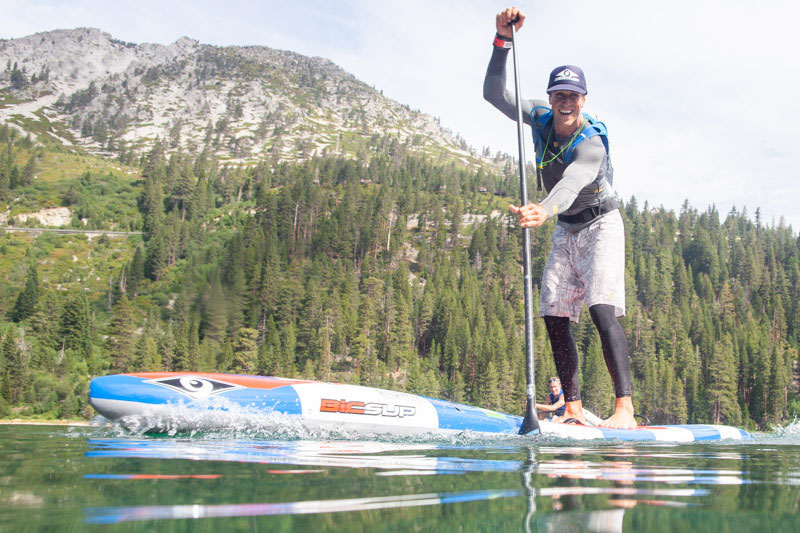
Take your SUP skills to the next level
Once you get comfortable on the board (it may take a few hours of paddling), you’ll likely be ready to progress beyond the basics.
1) Shifting foot positions
You typically want your feet centered on the board. The further back you are on the board, the faster it will turn through the water, but it will also be less stable. The more forward you are, the slower the board will turn.
- If you have to move your feet, do so slowly and deliberately. Keep your paddle in the water and slide one foot forward or backwards a few inches. Slide your other foot to match it. Try to avoid lifting your foot completely off the board as that will put all your weight on one side of the board which may tip it over.
- Slow, steady movements are best. The same is true for moving your feet towards the edge or center of the board. I like to shift my heel and then my toes in or out as needed to reposition my feet side to side.
2) Practice falling off the board
Another key stand up paddleboarding tip to practice before you head out into the middle of a lake is getting back onto the board from deep water.
- Head out until the water depth is over your head and ease yourself off your board and into the water, avoiding any rocks or other obstruction below the surface.
- With your paddle still in hand, situate yourself at the center of the board. If it flipped over when you got in the water, flip it right side up. Place the paddle parallel to the board’s centerline. Grab the far edge of the board with both hands.
- Kick your feet up towards the surface of the water and then using your hands and your feet, drive yourself up onto the board. Don’t try and pull yourself up from the water onto the board. You’ll likely just tip the board over onto your head. It may take a few attempts to master, but it’s a key skill, so take some time to get comfortable with it. Once you’re on the board and steady, move to a solid kneeling position and then slowly stand up.
3) Master handling waves, whether caused by boats or wind
It’s best to take waves bow, or nose, first. Especially boat wakes.
- When you see waves coming towards you, steer the board so that the nose is pointing directly into the waves. Then slowly and steadily paddle into the waves. Keep your knees bent and your eyes focused forward at the next wave. The nose will rise up over the wave crest and then slide down the trough.
- Be sure to try to keep your paddle blade in the water by taking smooth, frequent strokes. Don’t lift your paddle up out of the water and try to ride out the waves. As you get more comfortable, you’ll be able to handle waves more easily.
4) Experiment with different paddle strokes
The basic forward stroke is pretty straightforward, but it’s also somewhat limiting. It doesn’t turn the board very fast and it adds forward momentum through the turn, which isn’t always ideal.
- Draw stroke: reach the paddle out a few feet from the nose of the board with the blade parallel to the edge of the board and pull towards the nose of the board. Watch as the nose pulls towards the blade.
- Sweep stroke: reach forward with the paddle but instead of pulling back along the edge of the board as you would with a forward stroke, sweep the paddle out in an arc through the water, bringing it towards the back of the board. Watch as the board swings to the opposite side of the paddle.
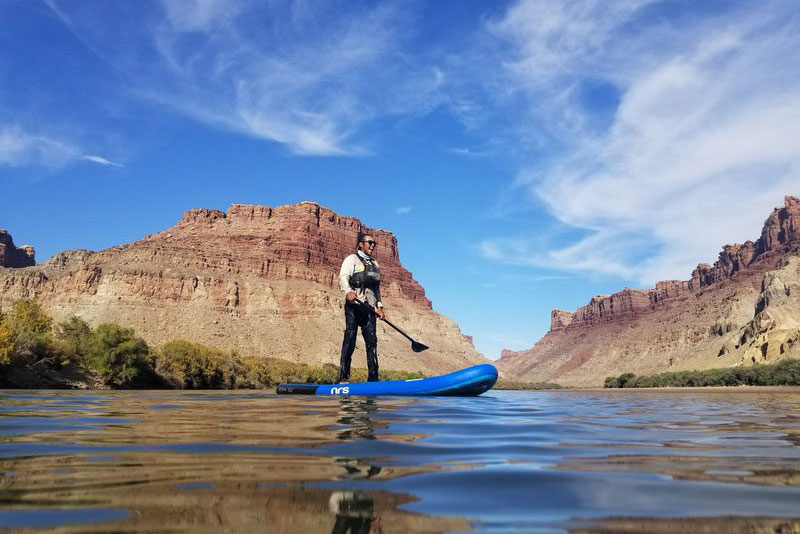
Once you’ve mastered the basics of stand up paddleboarding on flatwater you can progress to paddleboarding on rivers. Be sure to learn the basics of river flows, and as you learn how to navigate mellow rivers, you can progress to faster current.
With these basic stand up paddleboarding tips, you’ll be able to explore your local waterways from a new perspective in no time.
Photos: Bird’s eye view of SUP paddler – Red Zeppelin/Unsplash; SUP gear by Francisco Deane/Unsplash; Paddler kneeling on a SUP – Dylan Silver; Lake Tahoe stand up paddler – Dylan Silver; Paddleboarding on the Colorado River – Ashley Sozzi
Related Posts
Sign up for Our Newsletter
